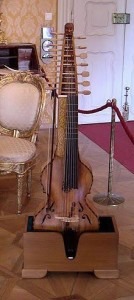 “Minors of the Majors” invites you to discover compositions by the great classical composers that for one reason or another have not reached the musical mainstream. Please enjoy, and keep listening!
“Minors of the Majors” invites you to discover compositions by the great classical composers that for one reason or another have not reached the musical mainstream. Please enjoy, and keep listening!
Franz Joseph Haydn entered into the services of the Esterházy family in 1761. Highly influential, and among the most affluent of Hungarian nobility, the Esterházy’s were also important patrons of music and the arts. As a devout music lover and amateur performer, Prince Nikolaus Esterházy demanded a steady stream of practical compositions from his newly appointed Kapellmeister. In fact, Haydn was initially reprimanded for apparently neglecting the personal musical wishes of his employer. “Capelmeister Haydn is urgently enjoined to apply himself to compositions more diligently than heretofore,” the Prince wrote, “and especially to write such pieces as be played on the gamba, of which pieces we have seen very few up to now; and to be able to judge his diligence, he shall at times send us the first copy, cleanly and carefully written, of each and every composition.”
Franz Joseph Haydn: Baryton Trio No. 97 in D Major, Hob. XI:97
The instrument of particular concern to the Prince was the Baryton, a bowed string instrument of the viol family. The instrument features six or seven strings arranged over a fretted fingerboard, plus a lower set of wire strings that vibrate sympathetically. Taking his employer’s reprimand to heart, Haydn quickly set to work and started composing baryton trios. Predictably, the Prince was overjoyed, “I have this moment received from Haydn three pieces which please me very much,” he wrote to his administrator, “you are accordingly to pay him in my name twelve ducats from the treasure and to tell him at the same time that he is to write six more pieces like those he has just sent me, together with two solos, to be delivered as soon as possible.”
Over the next ten years, Haydn wrote nearly 200 compositions for various ensembles with baryton. These works have long been neglected but are currently experiencing a bit of a Renaissance. Scholars suggest, “Despite the limitations of the combination, Haydn’s genius is evident in the kaleidoscopic range of melodic and textural ideas and the witty interplay between instruments.” Whether you share that view or not, the Baryton trio was the most intensively cultivated genre in Haydn’s earlier career.
You May Also Like
- Minors of the Majors
Francis Poulenc: Sonata for Trumpet, Horn and Trombone, Op.33 Jean Cocteau magnanimously announced in 1918, that his principal goal was the elimination of all foreign and specifically German elements from French music and culture. - Minors of the Majors
Franz Liszt: Cantantibus organis The 1860’s were not particularly kind to Franz Liszt. For one, the Tsar of Russia successfully blocked his long-awaited marriage to the Princess Carolyne Sayn-Wittgenstein. - Minors of the Majors
Gustav Mahler: Piano Quartet in A Minor Gustav Mahler, son of an aspiring tavern proprietor and a soap-maker’s daughter, was considered a Wunderkind! - Minors of the Majors
Gioacchino Rossini: 3 Choeurs Religieux In 1829, Gioachino Rossini (1792-1868) completed his thirty-fourth opera, William Tell.
More Anecdotes
- Bach Babies in Music
Regina Susanna Bach (1742-1809) Learn about Bach's youngest surviving child - Bach Babies in Music
Johanna Carolina Bach (1737-81) Discover how family and crisis intersected in Bach's world - Bach Babies in Music
Johann Christian Bach (1735-1782) From Soho to the royal court: Johann Christian Bach's London success story - A Tour of Boston, 1924
Vernon Duke’s Homage to Boston Listen to pianist Scott Dunn bring this musical postcard to life
